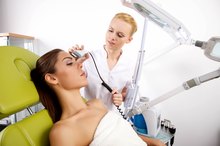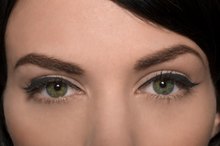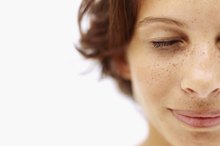What does fact checked mean?
At Healthfully, we strive to deliver objective content that is accurate and up-to-date. Our team periodically reviews articles in order to ensure content quality. The sources cited below consist of evidence from peer-reviewed journals, prominent medical organizations, academic associations, and government data.
- "Journal of Clinical Sleep Medicine"; Illuminating Rationale and Uses for Light Therapy; Afshin Shirani, M.D., and Erik K. St. Louis, M.D; May 15, 2009
- "Journal of Clinical Sleep Medicine"; Illuminating Rationale and Uses for Light Therapy; Afshin Shirani, M.D., and Erik K. St. Louis, M.D; May 15, 2009
The information contained on this site is for informational purposes only, and should not be used as a substitute for the advice of a professional health care provider. Please check with the appropriate physician regarding health questions and concerns. Although we strive to deliver accurate and up-to-date information, no guarantee to that effect is made.
Blue Light Therapy Benefits
Blue light therapy is a form of phototherapy treatment that applies the wavelengths of blue light to treat specific disorders. Phototherapy in the form of blue light waves is a standard treatment to reduce high levels of bilirubin, or jaundice, in the blood of newborns. According to a study published in 2009 in the “Journal of Clinical Sleep Medicine,” with the exception of people with retinal pathology or those taking photosensitizing medications, the benefits of light therapy outweigh any potential risks.
If you are experiencing serious medical symptoms, seek emergency treatment immediately.
Mood Disorders
Seasonal affective disorder, or SAD, is a type of depression that results from a lack of daylight in the winter months. Although many people experience minor mood fluctuations due to a lack of adequate sunshine, the more severe forms of SAD can result in debilitating fatigue, changes in appetite and severe mood disorders. Most people treated with blue light therapy for SAD show improvement within seven days, according to MayoClinic.com.
Sleep Disorders
Can I Use My Grow Light for Light Therapy?
Learn More
In order for the body’s circadian rhythm to function properly, the brain must receive both light and dark signals within each 24-hour period. In daylight hours, the circadian system responds to the blue wavelengths of the color spectrum by releasing serotonin, a feel-good hormone that among other things contributes to a sense of well-being. After sunset, the body halts the production of serotonin and releases melatonin, the sleep hormone. For mental and physical health, both hormones are vital.
Because today’s high-tech world gives people the flexibility to alter their wake and sleep schedule according to their personal requirements, many wake before sunrise, spend their workday in artificial light and return home in the dark. Although full spectrum, or bright white, light was previously thought to be necessary to treat sleep disorders, the short wavelength of blue light is now preferred, according to the "Journal of Clinical Sleep."
- In order for the body’s circadian rhythm to function properly, the brain must receive both light and dark signals within each 24-hour period.
- In daylight hours, the circadian system responds to the blue wavelengths of the color spectrum by releasing serotonin, a feel-good hormone that among other things contributes to a sense of well-being.
Skin Repair
Blue light therapy is often used to treat acne, rosacea, psoriasis and wrinkles caused by sun damage and age. For acne patients who wish to avoid the side effects and potential long-term consequences of prescription medications, light therapy may be an ideal alternative. Because blue light frequencies effectively destroy bacteria, many dermatologists report patients treated with narrow-band blue light show significant improvement in acne conditions.
According to the website DermNet NZ, a number of studies show some benefit to the use of blue light treatment, including one that found blue light to be more effective in treating acne than the topical application of the antibiotic clindamycin 3.
- Blue light therapy is often used to treat acne, rosacea, psoriasis and wrinkles caused by sun damage and age.
- Because blue light frequencies effectively destroy bacteria, many dermatologists report patients treated with narrow-band blue light show significant improvement in acne conditions.
Related Articles
References
- "Journal of Clinical Sleep Medicine"; Illuminating Rationale and Uses for Light Therapy; Afshin Shirani, M.D., and Erik K. St. Louis, M.D; May 15, 2009
- Science Daily: Blue-Blocking Glasses to Improve Sleep and ADHD Symptoms Developed
- DermNet NZ: Lasers, Lights and Acne
- Vimont C. Should you be worried about blue light? American Academy of Ophthalmolgists. Updated August 24, 2017.
- Abokyi S, To CH, Lam TT, Tse DY. Central role of oxidative stress in age-related macular degeneration: Evidence from a review of the molecular mechanisms and animal models. Oxid Med Cell Longev. 2020;2020:7901270. doi:10.1155/2020/7901270
- Chalam KV, Khetpal V, Rusovici R, Balaiya S. A review: role of ultraviolet radiation in age-related macular degeneration. Eye Contact Lens. 2011;37(4):225-32. doi:10.1097/ICL.0b013e31821fbd3e
- Lawrenson JG, Hull CC, Downie LE. The effect of blue-light blocking spectacle lenses on visual performance, macular health and the sleep-wake cycle: A systematic review of the literature. Ophthalmic Physiol Opt. 2017;37(6):644-654. doi:10.1111/opo.12406
- Ramsey DJ, Ramsey KM, Vavvas DG. Genetic advances in ophthalmology: The role of melanopsin-expressing, intrinsically photosensitive retinal ganglion cells in the circadian organization of the visual system. Semin Ophthalmol. 2013;28(5-6):406-21. doi:10.3109/08820538.2013.825294
- Wahl S, Engelhardt M, Schaupp P, Lappe C, Ivanov IV. The inner clock-Blue light sets the human rhythm. J Biophotonics. 2019;12(12):e201900102. doi:10.1002/jbio.201900102
- Hazanchuk V. Should you use night mode to reduce blue light? American Academy of Ophthalmology. Updated May 7, 2019.
- Tosini G, Ferguson I, Tsubota K. Effects of blue light on the circadian system and eye physiology. Mol Vis. 2016;22:61‐72.
Writer Bio
Susan Brassard writes about natural health-related topics, complementary and alternative medicine and issues relative to a holistic approach to the aging process. Following a career in business and finance, she obtained a Master of Arts in gerontology and several certifications in energy therapies. She is the author of a workbook and resource guide for older adults.








